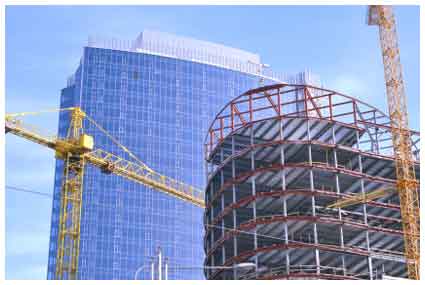Construction hits 50-month high in employment, adds to private and public GDP gains Editor’s note: Construction Citizen is proud to partner with AGC America to bring you AGC Chief Economist Ken Simonson's Data DIGest. Check back each week to get Ken's expert analysis of what's happening in our industry.
Editor’s note: Construction Citizen is proud to partner with AGC America to bring you AGC Chief Economist Ken Simonson's Data DIGest. Check back each week to get Ken's expert analysis of what's happening in our industry.
Nonfarm payroll employment increased by 204,000, seasonally adjusted, in October and 2,329,000 (1.7%) over 12 months as the estimates for August and September were revised substantially up, the Bureau of Labor Statistics (BLS) reported on Friday. Construction employment rose for the fifth straight month, to a 50-month high of 5,834,000, up 11,000 from September and up 185,000 (3.3%) over the past year. Total hours worked (aggregate weekly hours) in construction increased by 3.8% since October 2012, implying that contractors are extending working hours slightly as well as hiring new workers. Residential construction employment (residential building and specialty trade contractors) climbed by 4,800 for the month and 103,600 (5.0%) for the year. Nonresidential employment (building, specialty trades, and heavy and civil engineering construction) rose by 6,600 and 81,100 (2.3%), respectively. The unemployment rate for jobseekers who last worked in construction fell to the lowest October level in six years—9.0%, down from 11.4% in October 2012 and 17.3% in October 2010. (Industry unemployment data are not seasonally adjusted and should only be compared year-over-year, not across months.) Since October 2010 the number of unemployed construction workers has dropped by 712,000, not seasonally adjusted. But construction employment rose by only 323,000, implying that many experienced workers left the industry for employment elsewhere, further training or schooling, retirement, or left the workforce. These departures may make it hard for contractors to find skilled workers if demand rises further, even though the unemployment rate remains higher than for the overall economy (7.0%, not seasonally adjusted) and wage growth and job openings do not yet signal any tightness nationally.
Real (net of inflation) gross domestic product (GDP) increased 2.8% at a seasonally adjusted annual rate in the third quarter, up from 2.5% in the second quarter, the Bureau of Economic Analysis reported on Thursday. Private real fixed investment in nonresidential structures (including mines and wells) jumped 12% and 18%, respectively. Real residential investment leaped 14% and 15%. Real government gross investment in structures rebounded to a 6.7% gain after falling 0.7% in the second quarter; state and local government investment in structures rose 7.2%, while federal government investment slipped 0.7%. Price indexes rose 1.9% in the third quarter and 0.6% in the second for GDP; 2.8% and 5.2% for private nonresidential structures; 3.0% and 5.1% for residential; and 2.2% and 2.3% for government structures.
“Apartment fundamentals continue to outperform all major property types, but the rapid increase in apartment development has many worried that even with robust demand, the sector could struggle to absorb increased new supply,” Wells Fargo Economics wrote on Thursday. “On a national basis, fundamentals suggest the concern is overblown as solid apartment demand, which includes improving household formation and employment growth, are expected to continue to support the rental market. Moreover, tight lending standards and a growing ‘echo-boom’ population, which has a high propensity to rent and large student loan burden, will likely keep the share of renters moving out of rental properties to purchase a home below the long-run average. In fact, the apartment vacancy rate is at its lowest level in more than a decade at 4.2% in the third quarter, according to REIS,” a real-estate data firm.
“The revival of construction on a 30-story mixed use tower in downtown Portland, Ore., is…an indication that the demand for new office space, which had been limited to the nation’s largest markets, is spreading to midsize cities,” the Wall Street Journal reported on Wednesday. “Walter Page, director of office research for real-estate data firm CoStar Inc., estimates that 60% of current construction is in five metropolitan areas including New York and San Francisco, while those five cities would typically garner just 35% to 40%.…as the economy mends and office vacancies edge downward, [demand is rising] for office space in cities that have had little supply in recent years. In Milwaukee, for instance, Northwestern Mutual Life Insurance Co. is planning to build a 32-story tower on the edge of the city’s downtown. And landlord Brandywine Realty Trust announced on Oct. 31 that it would start work on a 47-story apartment and office tower in downtown Philadelphia…No one in the industry is predicting a new construction boom, and risky speculative construction –where developers build before lining up tenants—is still frowned upon. But office construction is expanding. McGraw Hill Construction [MHC] projects that 87 million square feet of office-building projects will start in 2014, up 16% from an estimated 75 million square feet in 2013 but still far below the 150 million to 200 million square feet that was typically started annually before the recession.”
The Dodge Momentum Index, a monthly measure of the initial report for nonresidential building projects in planning, slipped 0.9% in October compared to the previous month, MHC reported on Thursday. MHC says the index has “been shown to lead construction spending for nonresidential buildings by a full year….new plans for commercial buildings, the more cyclically sensitive of the two components, dropped 2.1% while institutional building plans held steady. On the commercial side, a large decline in plans for new offices and stores outweighed strong gains for new hotel development.”
The Data DIGest is a weekly summary of economic news; items most relevant to construction are in italics. All rights reserved. Sign up at www.agc.org/datadigest.
AGC's Data DIGest: November 4 – 11, 2013
by Ken Simonson | November 11, 2013



Add new comment